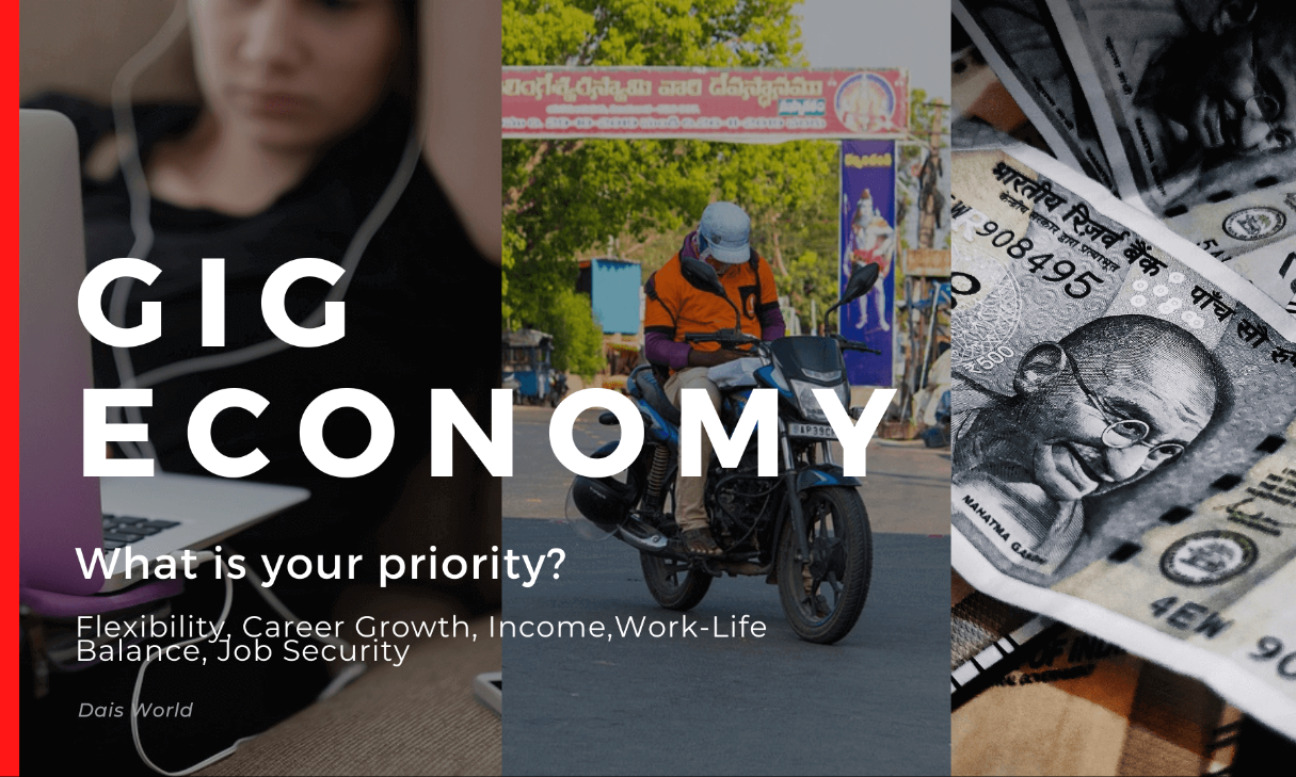Editorial > Gig Economy in India: Flexibility at the Cost of Security?
Gig Economy in India: Flexibility at the Cost of Security?

Dais Editorials | 16/11/2024 06:05 PM
Origins of the Gig Economy
The concept of the "Gig Economy" traces its origins back to the 1910s, when jazz musicians referred to their individual performances as "gigs," highlighting the per-job nature of their work. Over time, this term evolved beyond music to describe a growing global phenomenon: an economy built on short-term, flexible jobs. Unlike traditional employment, the gig economy allows workers to engage in multiple part-time roles, often across diverse industries, but typically without the stability of conventional benefits such as healthcare or retirement plans.
This shift from structured employment to task-based freelancing reflects broader changes in how people approach work, driven by the demand for flexibility, autonomy, and diverse income streams. While the gig economy offers these advantages, it also challenges the conventional notions of job security and long-term career growth.
Today, the term "gig economy" encapsulates a significant segment of the global workforce, particularly in countries like India, where technology and digital platforms have accelerated its expansion. From its humble beginnings in music halls to becoming a dominant economic force, the gig economy has redefined the way people earn a living, paving the way for a new era of work.
Reference from The Progress Catalyst
Rise of the Gig Economy in India
The gig economy has continued its rapid rise in India, solidifying its role as a dominant force in the economy through 2022 to 2024. With an increasing number of people turning to gig work for livelihood flexibility and opportunity, the sector shows no signs of slowing down. This growth has been fueled by the continued expansion of freelancing platforms and gig marketplaces across India, making it easier than ever for people to find work and connect with clients across various industries and regions.
According to recent insights, companies like Flipkart, Urban Company, Bigbasket, Swiggy, Zomato, Amazon, Dunzo, PharmEasy, Ola Cabs, and Porter have maintained their positions as leading players in India’s gig economy. The most in-demand roles this year include telecaller executives, accounting support, manual labor, and on-demand services like those provided by platforms such as Helpr, Didi, Airbnb,Urban Clap,Dunzo and Uber.
According to the article "32 Highest Paying Gig Economy Jobs in 2023" from The Ways To Wealth[1], the highest-paying gig economy job in India is a Data Scientist. Data Scientists are responsible for large-data analysis and interpretation, and the average salary range for this job is between Rs. 7 – 15 LPA, with the highest salaries going as high as Rs. 20 – 40 LPA.
 A Generational Shift Towards Flexibility
A Generational Shift Towards Flexibility
Another factor driving the growth of the gig economy in India is the increasing number of millennials and Gen Zs who are entering the workforce. These generations are more interested in flexible work arrangements and are increasingly turning to gig work as a way to achieve that flexibility.
However, there are also challenges that need to be addressed if the gig economy is to continue to grow in a sustainable way. One of the biggest challenges is the lack of benefits and protections for gig workers, such as health insurance and retirement savings. This is an issue that will need to be addressed by the government and the private sector if the gig economy is to thrive in the longer term.
Overall, the future of the gig economy in India looks bright, with more and more people turning to gig work as a way to earn a living. However, it will be important to address the challenges that come with this growth in order to ensure that gig workers are able to thrive and succeed in the years to come.
The Pandemic’s Influence on Gig Work Growth
The growth of the gig economy in India has been driven by a combination of factors, including the pandemic, mass layoffs, and a changing mindset of the workforce. The pandemic has had a significant impact on the economy, resulting in mass layoffs and increased demand for flexible work schedules. This has led to an increase in the number of people looking for alternative sources of income and has created an opportunity for the gig economy to thrive. Additionally, the widespread adoption of smartphones and the availability of high-speed internet has made it easier for workers and businesses to connect through online platforms, facilitating the growth of the gig economy [1]. Furthermore, the changing workforce mindset has also contributed to the development of the gig economy. People are now more open to the idea of working independently and taking on freelance projects, which has further boosted the gig economy [2].
Sources:
Challenges faced by the Gig Workers in India
 There are several evaluation parameters to consider when deciding between a gig and a full-time job. Here are some of the most important ones:
There are several evaluation parameters to consider when deciding between a gig and a full-time job. Here are some of the most important ones:
- Income: Look at the potential earning capacity of both options. Full-time jobs are likely to offer a steady salary and benefits, while gigs may offer more flexibility but with less financial security.
- Benefits: Consider the benefits that come with a full-time job, such as health insurance, retirement plans, and paid time off. Gig work typically doesn't offer these benefits, which can be a significant disadvantage.
- Flexibility: Gigs offer more flexibility in terms of schedule and workload, which can be a major advantage for some people. Full-time jobs typically require a set schedule and may not allow for much flexibility.
- Career growth: Consider the potential for career growth and advancement with both options. Full-time jobs may offer more opportunities for advancement, while gig work may offer opportunities to build a diverse skill set.
- Work-life balance: Consider your personal priorities in terms of work-life balance. Full-time jobs may offer more stability, but may also require more time and energy. Gigs may offer more flexibility, but may also require more hustle and self-motivation.
- Job security: Full-time jobs offer more job security than gigs, which can be a major factor in decision-making. Gigs are typically short-term and may not offer the same level of stability.
A Balanced Perspective on the Future
Ultimately, the decision between a gig and a full-time job will depend on your personal circumstances and priorities. Consider these factors carefully before making a decision.
Consider taking a look at these 10 key reports and statistics on the Gig Economy, focusing on its past, present, and future:-
- Global Gig Economy Growth Projection - By 2023, global transactions in the gig economy were expected to grow to about $455 billion, with a yearly growth rate of approximately 17%. (Mastercard)
- U.S. Gig Economy Participants - In 2020, at least 59 million American adults participated in the gig economy, representing about 36% of the U.S. workforce. (Zippia)
- Freelancer Income - Freelancers in the U.S. earned an average of $21 per hour in 2020, significantly higher than national averages in many countries. (Payoneer)
- Impact of COVID-19 - The COVID-19 pandemic led to an increase in gig work, with 23 million new participants joining in the U.S. alone in 2020. (daVinci Payments)
- Gender Disparity - Men (31%) were more likely to be employed in the gig economy than women (18%). Female freelancers earn about 84% less than their male counterparts across all fields. (Edison Research, TeamStage)
- Age Demographics - The most prominent age group in the gig economy is 25–34 years old, with an average hourly wage of $19. (Payoneer)
- Workforce Preference - In surveys, 45% of gig workers preferred remaining independent and adding clients to increase income over seeking a traditional full-time job. (BCG Henderson)
- Satisfaction and Work Hours - Despite potentially working long hours, gig workers report higher levels of happiness and satisfaction compared to traditional employment. (BCG Henderson)
- Future Workforce Trends - By 2027, it is projected that over 50% of the U.S. workforce might be freelancers, indicating a significant shift towards gig work. (WiFiTalents)
- Corporate Adaptation - Over 80% of large corporations plan to increase their use of gig workers or freelancers in their workforce strategy, highlighting a trend towards more flexible work arrangements. (Intuit 2020 report)
The gig economy is growing globally, with freelancers enjoying flexibility and income potential. However, for India, a structured work environment offers greater stability, benefits, and career growth, which are essential for financial security and long-term development. Fostering organised sectors can better support economic resilience and workforce well-being. A bigger concern remains: Can India strike the right balance between the flexibility of the gig economy and the stability of structured employment to ensure a secure and sustainable future for its workforce?
Editor-In-Chief - Abhishek Deb
Follow Up
Send us your comments, suggestions, requests, feedback at connect@dais.world
You were reading a Dais Editorial©2024







